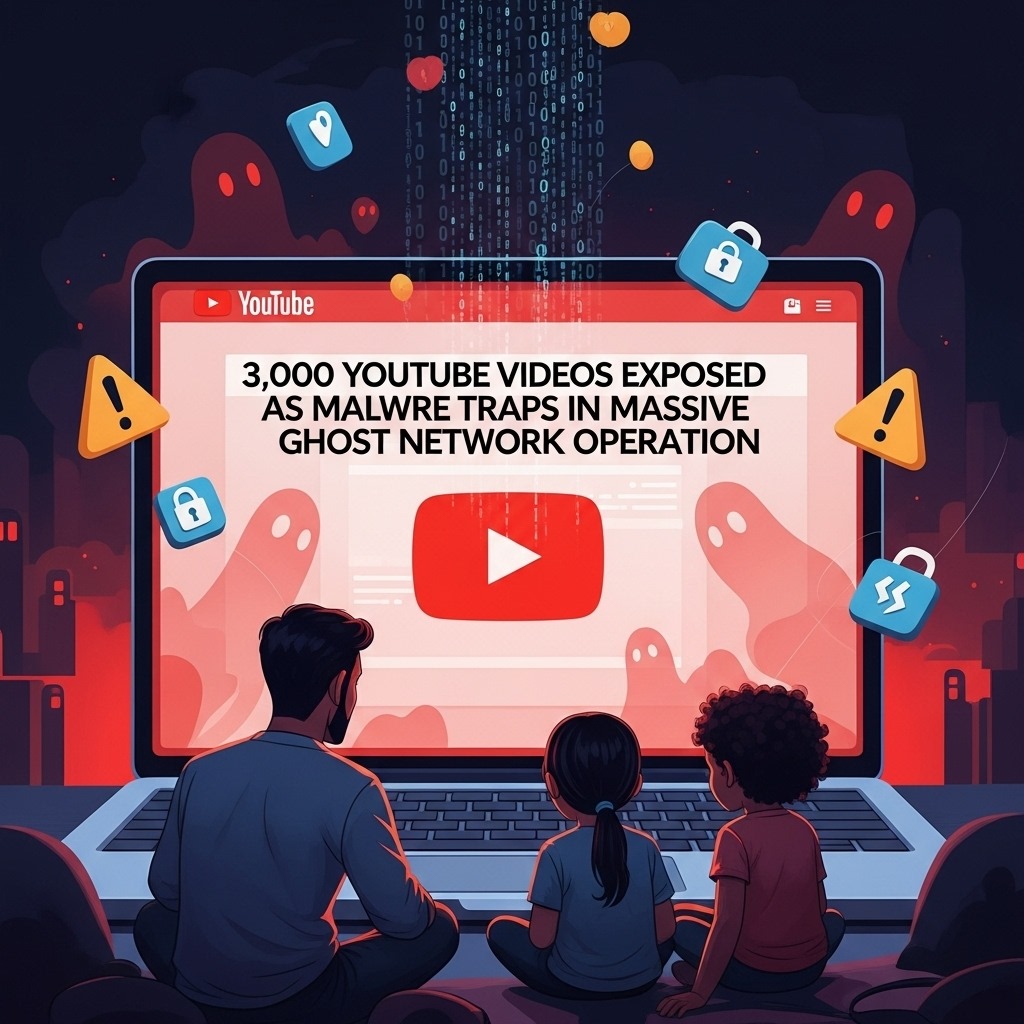
Hello, Smart Learners and Smart Parents!
Picture this: Your kid searches “free Photoshop download” on YouTube. They find a video with 200,000 views, tons of thumbs-ups, and comments saying “it works!” They click the link in the description. Boom, your family computer is now infected with malware that’s quietly stealing passwords, bank details, and personal information.
Sound scary? It should. Because it’s happening right now, and it’s bigger than anyone expected.
What’s Going On?
Security researchers at Check Point just exposed something they’re calling the “YouTube Ghost Network”, a massive operation that’s been running since 2021. We’re talking about over 3,000 malicious videos that trick people into downloading malware instead of the software they’re actually looking for.
And here’s the kicker: these aren’t just random spam accounts. These criminals are hijacking real YouTube channels, some with hundreds of thousands of subscribers, and turning them into malware distribution centers. That channel you trusted? The one who used to post guitar tutorials? It might now be posting videos that’ll wreck your computer.
How Does This Scam Actually Work?
Think of it like a well-organized crime syndicate, but for YouTube. The attackers use three types of accounts working together:
The Video Accounts upload the fake tutorials, stuff like “Free Adobe Photoshop 2025!” or “Unlimited Roblox Hack!”, and pack the descriptions with download links.
The Post Accounts spam YouTube’s community tab (you know, that feature nobody really uses?) with even more malicious links.
The Interact Accounts are the clever ones. They leave fake comments like “This totally worked for me!” and give thumbs-ups to make everything look legit.
It’s like they’ve created a fake community of trust around dangerous content. And it’s working disturbingly well.
What Are They Actually Spreading?
These aren’t just annoying viruses. We’re talking about serious stuff called “stealers”, malware specifically designed to grab your valuable information. Names like Lumma Stealer, Rhadamanthys, and RedLine are popping up everywhere in this network.
One hijacked channel called @Afonesio1 had 129,000 subscribers. The attackers took it over twice, once in December 2024 and again in January 2025, just to spread their poison. Another channel, @Sound_Writer, has been compromised for over a year, targeting people looking for cryptocurrency software.
The Sneaky Part
These criminals are smart. They hide their malicious links behind legitimate-looking services like Google Drive, Dropbox, and MediaFire. They even use URL shorteners so you can’t see where you’re really going until it’s too late. Some links lead to fake websites built on Google Sites or Blogger, platforms we generally trust, which then redirect you to the actual malware.
Everything looks professional. The video quality is good. The comments are encouraging. The view counts are high. Your brain sees all these “trust signals” and thinks, “This must be safe.”
It’s not.
Why This Matters to Your Family
If you have kids who play Roblox, use TikTok, or watch YouTube tutorials to learn things, they are the prime targets. The videos often promise:
- Free premium software (Photoshop, video editors, music production tools)
- Game cheats and hacks (especially for Roblox and Minecraft)
- Cryptocurrency mining tools
- Cracked versions of expensive programs
Basically, anything a young person might search for when they don’t have money to buy the real thing.
What Can You Do?
For Parents:
- Have honest conversations about why “free” premium software is almost always a trap
- Teach your kids that high view counts don’t mean something’s safe
- Set up good antivirus software and keep it updated
- Monitor what your kids are downloading (without being creepy about it)
For Everyone:
- Never download software from YouTube video descriptions
- If you need free software, use official websites or verified alternatives like open-source programs
- Look for red flags: generic comments, shortened URLs, pressure to “download now”
- When something seems too good to be true (free $500 software!), it absolutely is
For Kids and Teens:
- That “working crack” probably isn’t working, it’s stealing your data
- Real software companies don’t distribute through YouTube links
- Those encouraging comments? They’re probably fake accounts
- Ask a trusted adult before downloading anything
The Bigger Picture
This Ghost Network thing isn’t going away. In fact, it’s tripled in size just this year. Google is removing videos as fast as they can, but the network’s structure means banned accounts get replaced instantly. It’s like playing whack-a-mole with malware.
Security expert Eli Smadja put it perfectly: “What looks like a helpful tutorial can actually be a polished cyber trap.”
The internet can be an amazing place to learn, create, and connect. But it’s also got some dark corners, and this YouTube Ghost Network is one of them. Stay skeptical, stay informed, and remember: if you’re not paying for the product, you might actually be the product.
Stay safe out there, Smart Learners! And maybe stick to the official Adobe website for your Photoshop needs.
This is so insightful. I’ll be looking into my nephews tab from time to time, he’s constantly combing the Internet for video games.
This is an amazing read.Thanks fir this information!